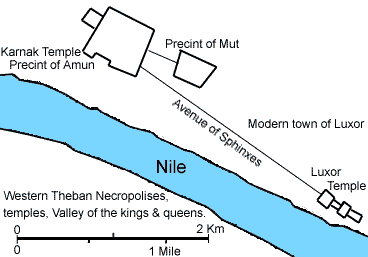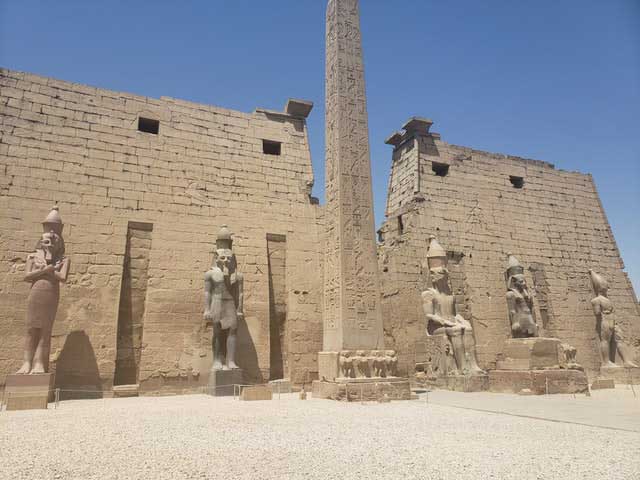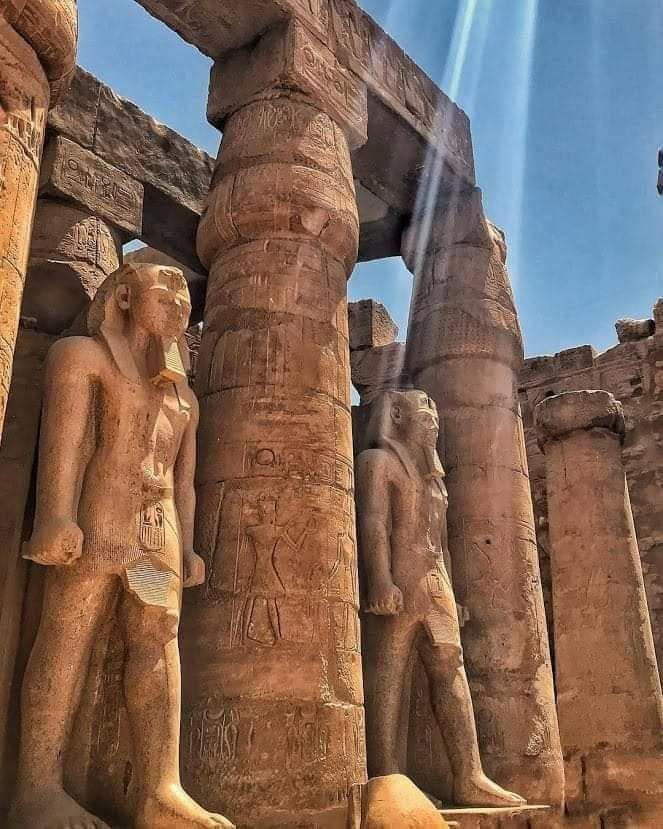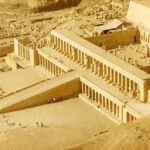Luxor Temple might be the greatest testament to why Luxor has earned its nickname, “The World’s Largest Outdoor Museum”. Luxor Temple is located in the modern city of Luxor, which is built on the site of the ancient Egyptian capital of Thebes.
The Luxor Temple was constructed of sandstone blocks from Nubia. The temple is surrounded by mud-brick walls which symbolize the separation between the world and the sacred realm of the gods. The Temple’s design during the New Kingdom exhibited a set of common design features in the construction of the temple. The Luxor Temple displays many of the features typical of temple construction known during the New Kingdom.
This article contains information about visiting Luxor Temple including:
Where is Luxor Temple located?
The Luxor Temple is a large Ancient Egyptian temple complex located on the east bank of the Nile River in the city today known as Luxor (ancient Thebes) and was constructed approximately 1400 BCE.
Luxor Temple is located in the historic city of Luxor, which is the modern name of the ancient Thebes. The temple of Luxor is one of the best-preserved of all of the ancient monuments containing large amounts of structure, statuary and relief carvings that are still intact to this day, making it one of the most impressive places to visit in the Luxor area and all of Egypt.
Temple of Luxor is one of the best preserved of all of the ancient monuments with large amounts of structure, statuary and relief carvings still intact, making it one of the most impressive visits in the Luxor area and all of Egypt, adding significantly to its allure is the juxtaposition that its setting provides. The modern city begins on one side and the Nile drifts by on the other. There are few places in Egypt where one is put so immediately and clearly in touch with the extraordinary length of Egypt’s history.

When Is the best time for visiting Luxor Temple?
Visit early when the temple opens, before the crowds arrive, or later at sunset when the stones glow. Whenever you go, be sure to return at night when the temple is lit up, creating an eerie spectacle as shadow and light play off the reliefs and colonnades.
The Temple’s location in the heart of Luxor makes Luxor Temple a very easy site to visit at almost any time of the day. Even when it is not open to visitors, the temple is visible during a stroll down the Nile corniche or through downtown Luxor. We recommend visiting the temple around sunset. The complex is beautifully lit in order to highlight the relief carvings as the light wanes and the columns emblazoned against the evening sky make for an incredible photo opportunity.
How much does it cost to visit the Temple of Luxor?
Tickets, which cost 160 Egyptian pounds (approximately $10) for adults and 80 Egyptian pounds (or $5) for students, can be purchased at the entrance’s gate.

Who built Luxor Temple and when?
Largely built by the New Kingdom pharaohs Amenhotep III (1390–1352 BC) and Ramses II (1279–1213 BC), this temple is a strikingly graceful monument in the heart of the modern town. Also known as the Southern Sanctuary, its main function was during the annual Opet celebrations, when the statues of Amun, Mut and Khonsu were brought from Karnak, along the Avenue of Sphinxes, and reunited here during the inundation.
Amenhotep III greatly enlarged an older shrine built by Hatshepsut, and rededicated the massive temple as Amun’s southern ipet (harem), the private quarters of the god. The structure was further added to by Tutankhamun, Ramses II, Alexander the Great and various Romans. The Romans constructed a military fort around the temple that the Arabs later called Al Uqsur (The Fortifications), which was later corrupted to give modern Luxor its name.

Why was Luxor Temple built?
Different than other temples in Luxor, the Luxor temple was not built in adoration to a god or to a god figure of the kings and pharaohs; instead, Luxor Temple was built in dedication to the rejuvenation of kingship. Many kings might have had they crowning at the Temple of Luxor, whether crowned in reality or conceptually as in the case of Alexander the Great, who claimed he was crowned at Luxor although facts contradict appear that he had never traveled south of Memphis which is considered the modern city of Cairo.
The design and layout of Luxor Temple
Temple of Luxor, along with the temple complex of Karnak, is the most famous temple complexes around Luxor and they are both located on the East Bank of the Nile. In ancient times an avenue of sphinxes that ran the entire 3 kilometers between them to connect the two sites. This avenue is currently under excavation, but the section nearest to Luxor Temple has already been restored.
In ancient times the temple would have been surrounded by a warren of mud-brick houses, shops and workshops, which now lie under the modern town, but after the decline of the city people moved into the – by then – partly covered temple complex and built their city within it. In the 14th century, a mosque was built in one of the interior courts for the local sheikh (holy man) Abu Al Haggag. Excavation works, begun in 1885, have cleared away the village and debris of centuries to uncover what can be seen of the temple today, but the mosque remains and has been restored after a fire.
The temple is less complex than Karnak, but here again you walk back in time the deeper you go into it. In front of the temple is the beginning of the Avenue of Sphinxes that ran all the way to the temples at Karnak 3km to the north, and is now almost entirely excavated.
The first Pylon
The massive 24m-high first pylon was raised by Ramses II and decorated with reliefs of his military exploits, including the Battle of Kadesh. The pylon was originally fronted by six colossal statues of Ramses II, four seated and two standing, but only two of the seated figures and one standing remain.
The open Courtyeard
Of the original pair of pink-granite obelisks that stood here, one remains while the other stands in the Place de la Concorde in Paris. Beyond lies the Great Court of Ramses II, surrounded by a double row of columns with lotus-bud capitals, the walls of which are decorated with scenes of the pharaoh making offerings to the gods. On the south (rear) wall is a procession of 17 sons of Ramses II with their names and titles. In the northwestern corner of the court is the earlier triple-barque shrine built by Hatshepsut and usurped by her stepson Tuthmosis III for Amun, Mut and Khonsu. Over the southeastern side hangs the 14th-century Mosque of Abu Al Haggag, dedicated to a local sheikh, entered from Sharia Maabad Al Karnak, outside the temple precinct.
The hypostyle hall
Beyond the court is the older, splendid Colonnade of Amenhotep III, built as the grand entrance to the Temple of Amun of the Opet. The walls behind the elegant open papyrus columns were decorated during the reign of the young pharaoh Tutankhamun and celebrate the return to Theban orthodoxy following the wayward reign of the previous pharaoh, Akhenaten. The Opet Festival is depicted in lively detail, with the pharaoh, nobility and common people joining the triumphal procession. Look out for the drummers and acrobats doing backbends.
The Sun Court of Amenhotep III
South of the Colonnade is the Sun Court of Amenhotep III, once enclosed on three sides by double rows of towering papyrus-bundle columns, the best preserved of which, with their architraves extant, are those on the eastern and western sides. In 1989 workmen found a cache of 26 statues here, buried by priests in Roman times, now displayed in the Luxor Museum.
Beyond lies the Hypostyle Hall, the first room of the original Opet temple, with four rows of eight columns each, leading to the temple’s main rooms. The central chamber on the axis south of the Hypostyle Hall was the cult sanctuary of Amun, stuccoed over by the Romans in the 3rd century AD and painted with scenes of Roman officials: some of this is still intact and vivid. Through this chamber, either side of which are chapels dedicated to Mut and Khonsu, is the four-columned antechamber where offerings were made to Amun. Immediately behind the chamber is the Barque Shrine of Amun, rebuilt by Alexander the Great, with reliefs portraying him as an Egyptian pharaoh.
Amenhotep III’s birth room
To the east a doorway leads into two rooms. The first is Amenhotep III’s ‘birth room’ with scenes of his symbolic divine birth. You can see the moment of his conception, when the fingers of the god touch those of the queen and ‘his dew filled her body’, according to the accompanying hieroglyphic caption. The Sanctuary of Amenhotep III is the last chamber; it still has the remains of the stone base on which Amun’s statue stood, and although it was once the most sacred part of the temple, the busy street that now runs directly behind it makes it less atmospheric.
Recommended Tours to valley of the kings:
Luxor private guided full-day tour
Guided Trip to Karnak and Luxor Temples: Private trip to East bank of Luxor
Cairo to Luxor: Private All-inclusive Day Tour by Flight
2 Days Trip to Luxor and Aswan from Hurghada
2 Days Trip to Luxor from Hurghada
Luxor Day Tour from Hurghada
Two Days Trip to Luxor from Marsa Alam
Two Days Trip to Luxor and Aswan from Marsa Alam
Luxor Day Tour from Marsa Alam
Luxor day tour from Aswan










